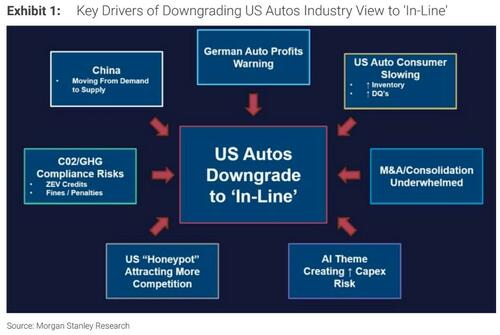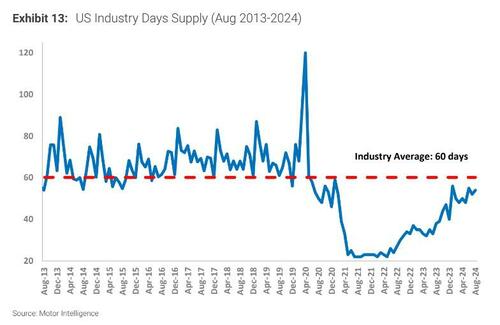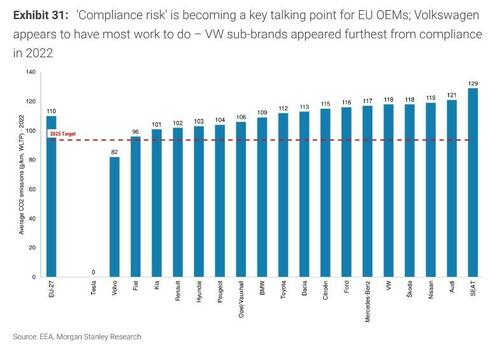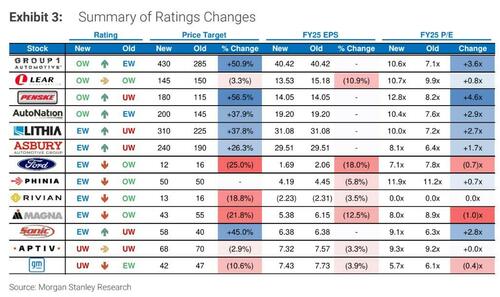Morgan Stanley's Jonas Downgrades GM, Ford, Other Autos, On Chinese Supply, Rising Delinquencies
Shares of auto names were under pressure to start the day on Wednesday after Morgan Stanley's Adam Jonas cut a majority of the sector in a broad note explaining new risks in a note out overnight.
Jonas downgraded names like GM, Ford, Rivian, Magna International, and Phinia, while upgrading dealers like AutoNation.
"The China capacity 'butterfly' has emerged and is flapping its wings," Jonas wrote. "China produces 9 million more cars than it buys, upsetting the competitive balance in the West. We are cutting estimates on China, price/mix, and lost share. There are better ways to play rate cuts. We upgrade dealers and downgrade F, GM, RIVN, MGA, and PHIN."
Jonas opened his note saying: "We are downgrading our view of the U.S. auto industry to In-Line from Attractive. At a high level, our downgrade is driven by a combination of international, domestic, and strategic factors that we believe may not be fully appreciated by investors."
"U.S. inventories are on an upward slope, while vehicle affordability (with near-record high average transaction prices and >$720 monthly payments) remains out of reach for many households. Credit losses and delinquencies continue to trend upward for less-than-prime consumers," he continued.
"China's two-decade-long growth engine has not stalled—it has reversed, with China profits flipping to losses and the country producing nearly 9 million units more than it sells locally, a figure equal to 15% of non-China global volume. Even if these units don't end up directly on U.S. shores, the 'fungibility' of lost share and profit by key U.S. players adds pressure here at home."
Jonas mentioned affordability concerns in the U.S. market, claiming it is highly stretched, with inventory levels now back to pre-COVID norms. Japanese, Korean, and electric vehicle (EV) brands are capturing market share, squeezing out others. U.S. manufacturers bear the brunt of the pressure with falling prices, weaker product mix, rising costs, and shrinking market share, he said.
Meanwhile, Auto Asset-Backed Securities (ABS) data shows a growing proportion of consumers are staying delinquent for longer, with higher severity rates. Although subprime defaults are lower in 2023 compared to 2022, prime defaults have increased.
He wrote that in 2023, China accounted for 29% of global auto sales, 32% of production, and over 40% of global auto capacity (with China operating at around 50% capacity utilization). Although tariffs may offer temporary relief, long-term pressures, including potential retaliatory actions, loom. Chinese-made EVs are expanding in export markets, offering superior affordability, variety, and increasingly competitive quality, eroding the market share of Western legacy automakers both internationally and domestically.
Jonas also cited capital discipline and regulatory risks in his note. He says the consolidation and M&A activity expected in the sector has not materialized as anticipated. Additionally, regulatory compliance risk, especially in terms of meeting stringent CO2 emissions standards, adds new pressure.
He added that OEMs are cutting back on EV programs but could face future financial penalties and enforcement actions. Recently added EV capacity is costly and may struggle with uncertain demand. While stock buybacks have been successful this year (GM has been the best-performing OEM YTD), we anticipate that this trend may not last. Consolidation, if it happens, will likely require further deterioration in industry fundamentals.
The capital intensity required to compete in Advanced Driver Assistance Systems (ADAS) and Autonomous Vehicles (AV) is often overlooked, Jonas says. As the AI and data themes gain traction in the automotive sector, automakers will need to invest tens of billions in proprietary AI models. We question the financial capability of many traditional automakers to make these investments.
Interestingly, he also said the temporary bounce from rate cuts would soon disappear, writing that history shows that any outperformance typically lasts only for about six months, with underperformance following in the subsequent six months. Investors must consider whether rates are falling for the right reasons, given that the auto industry remains highly cyclical, particularly when potential economic outcomes appear skewed to the downside.
The full note is available to Pro Subscribers in the usual place...






